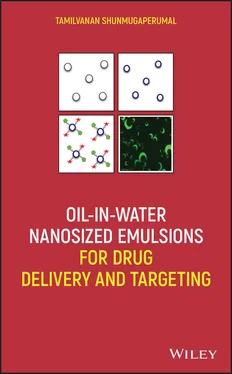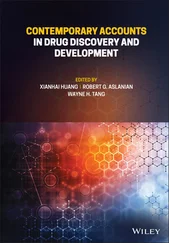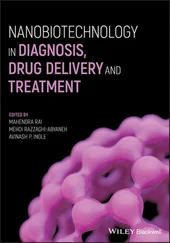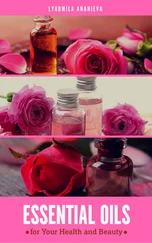1 ...8 9 10 12 13 14 ...27 In contrast to microemulsions, the o/w nanosized emulsions are thermodynamically instable, which can significantly reduce their applicability. As discussed in Chapter 1, the thermodynamic instability behavior of emulsions includes phenomena such as flocculation, coalescence, creaming, and Ostwald ripening. The physical instability of emulsions is due to the spontaneous tendency toward a minimal interfacial area and hence a minimal surface free energy between the dispersed oil phase and the aqueous continuous/dispersion medium. Minimizing the interfacial area is mainly achieved by two mechanisms: first, coagulation possibly followed by coalescence and second, by Ostwald ripening. Coalescence is often considered as the most important destabilization mechanism leading to coursing of dispersions and can be prevented by a careful choice of stabilizers or emulsifiers. The molecular diffusion of solubilizate (Ostwald ripening), however, will occur as soon as curved interfaces are present. During Ostwald ripening, the molecular diffusion of the lipophilic components occurs from small particles to larger particles due to the difference in escaping tendency (vapor pressure) between the two. Ostwald ripening is thus directly proportional to the solubility of the lipophilic component in the dispersion medium as well as to the particle size distribution. Various physical factors such as density difference between the dispersion medium and dispersed oil droplets, strong hydrodynamic agitation, interdroplet interaction, and the droplet interfacial viscoelasticity can affect or perturb the colloidal stability of emulsion droplets and thus their shelf life and therapeutic utility. Therefore, the stabilization of emulsion droplets is in many cases very important and desirable. There are different ways of stabilization of the o/w nanosized emulsions, all of which are related to the modification of the interface between the dispersion medium and emulsified oil droplets. Depending on the intended medical/therapeutic application of nanosized emulsions, various kinds of emulsifier molecules ranging from small surfactants or surface‐active polymers to poly‐layered interfacial coatings produced by multicomponent emulsifier films are considered.
This chapter initially starts with the different excipients or ingredients used in the emulsion preparation followed by a short overview on the lipophilic APIs’ incorporation pattern into the o/w nanosized emulsions. One more important section included in this chapter is how to optimize a formula for ensuring a quality emulsion formulation. This section introduces a case study that shows the Quality by Design (QbD) approach applied onto the emulsions to optimize a formula during preformulation studies. The effect of the amount of new chemical entity (NCE) or lipophilic API on the physical stability of emulsions, quantity of excipients (oils, emulsifiers, and other excipients) onto the API incorporation patterns, final particle size distribution of dispersed oil droplets of the emulsion on different storage temperature conditions, etc., will be the subject of interest to be discussed in this chapter. It is to be informed to readers that the discussion of majority of the traditional excipients (oils, emulsifiers, and other excipients) can also be found from Chapter 4wherein the classification of emulsions based on their generation appears.
2.2. FDA‐APPROVED OILS, EMULSIFIERS, AND AUXILIARY OR MISCELLANEOUS EXCIPIENTS
A comprehensive and non‐exhaustive list of different excipients used to make the o/w nanosized emulsions are shown in Table 2.1. Interestingly, the conventional or traditional excipients such as oils and emulsifiers are divided into two categories. The oils are classified according to their origin or source, i.e., animal, mineral, and plant. Based on the charges, the emulsifiers are majorly grouped as amphoteric, anionic, cationic, neutral, and nonionic. The emulsifiers are again separated into two groups depending on the specific activity they produce due to their charge presence. In one group, the amphoteric, anionic, neutral, and nonionic emulsifiers are gathered while the cationic emulsifier is kept alone in other group. All the emulsifiers without the cationic emulsifier is again sub‐grouped based on their solubility, whether lipid/oil or water, and hence the emulsifiers are grouped into two categories, i.e., oil soluble and water soluble. The cationic emulsifier is classified into two based on its chemical nature, i.e., carbohydrates or lipids, and hence the cationic polysaccharides and cationic lipids.
TABLE 2.1. Comprehensive and Non‐exhaustive List of Different Conventional or Traditional Excipients Used to Make the O/W Nanosized Emulsions
| Excipients |
Selected Examples |
| Oils |
Animal origin: Lanolin, squalene (shark liver oil) |
| Mineral origin: Paraffin light, paraffin oil, silicone oil, vaseline |
| Plant origin: Arachis oil, castor oil, corn oil, glycerol monostearate, medium‐chain monoglycerides, medium‐chain triglycerides, olive oil, sesame oil, soyabean oil, etc. |
| Emulsifiers: Amphoteric, anionic, neutral and nonionic |
Oil soluble: Cholesterol, cremophor RH, phospholipids (lipoid E 80) including phosphatidylcholine, phosphatidylethanolamine, sphingomyelin, etc. |
| Water soluble: Miranol C 2 M (disodium cocoamphodiacetate) Miranol MHT [(1 H ‐imidazolium, 4,5‐dihydro‐1‐(carboxymethyl)‐1‐(2‐hydroxyethyl)‐2‐undecyl‐, hydrogen sulfate (salt), monosodium salt)] Poloxamer [(poly(ethylene glycol)‐block‐poly(propylene glycol)‐block‐poly(ethylene glycol)] 188 and 407 Polysorbate/Tween 20 {2‐[2‐[3,4‐bis(2‐hydroxyethoxy)oxolan‐2‐yl]‐2‐(2‐hydroxyethoxy)ethoxy]ethyl dodecanoate} Polysorbate/Tween 80 {2‐[2‐[3,5‐bis(2‐hydroxyethoxy)oxolan‐2‐yl]‐2‐(2‐hydroxyethoxy)ethoxy]ethyl ( E )‐octadec‐9‐enoate} Transcutol P (diethylene glycol monoethyl ether) Tyloxapol [4‐(1,1,3,3‐tetramethylbutyl)phenol polymer with formaldehyde and oxirane] TPGS (tocopheryl polyethylene glycol succinate) |
| Emulsifiers: Cationic |
Lipid: DMPE, DOTAP, oleylamine, stearylamine |
| Polysaccharide: Chitosan |
| Miscellaneous |
α ‐Tocopherol, EDTA, glycerin, methylparaben, propylparaben, sorbitol, thiomersal, xylitol |
2.2.1. Issues Related to Oil Selection to Make the O/W Nanosized Emulsions for Medical Application
In general, the o/w nanosized emulsion should be formulated with compatible vehicles and additives. The components of internal (dispersed oil droplets) and external (aqueous continuous medium) phases of nanosized emulsions should be chosen to confer enhanced solubility and stability to the incorporated therapeutically active lipophilic API. In principle, the function of selected excipients should not only be limited to improve the overall physical stability of the emulsions or enhance the API's solubility but also they should contribute to influence the biofate or therapeutic index of the incorporated API after administration via parenteral, ocular, percutaneous, and nasal routes. The general considerations concerning excipient selection and optimum concentrations mainly in relation to the oils, emulsifiers, and miscellaneous excipients are presented comprehensively below.
At the time of preformulation studies, the solubility data of APIs need to be generated in the different oil selected, that too either alone or in combination of one oil with other oils in a definite ratio. Two more important points should be kept in mind before selecting the oil or oil combination. First point is compatibility of the oil or oil combination not only with other formulation excipients but also with the site of applications, i.e., ocular/skin tissues. Second point is related to auto‐ or self‐oxidation potential of oil or oil combination during and after emulsion manufacturing, because oils are triglycerides and are prone to auto‐ or self‐oxidation over the emulsion's processing and storage time periods. To minimize or to eliminate some extent the auto‐ or self‐oxidation, the additional excipient recommended to include in the emulsion formula is antioxidants, especially α ‐tocopherol in the concentration range from 0.001 to 0.002% w/w.
Читать дальше












